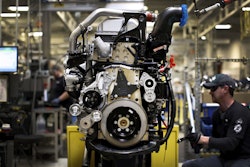Business is tough in today's global marketplace. Everyone is being asked to do more, with less. Across industries, including automotive, workers are being asked to be more efficient, and safety and risk management professionals are certainly not insulated.
Doing more with less
As mechanical systems and manufacturing processes approach maximum efficiency, it becomes increasingly difficult, or even impossible, to "do more, with less." Sure, you can make minor tweaks by twisting a knob here and pushing a lever there for additional output, but this additional output will come at a cost—a cost to quality, to machine reliability, etc.
Safety systems operate much like mechanical systems. When safety systems are functioning properly, organizations recognize risk proactively, identify and take appropriate actions and ultimately avoid incidents. When pushed past the point of maximum efficiency, however, output quality suffers. This leads to incidents and safety hazards going unrecognized and unchecked, which is clearly unacceptable.
Although it may be counterintuitive, especially since quality could suffer, doing more with less might actually be the best solution moving forward. New services and products allow a safety and risk management professional to be more efficient and effective.
Every mechanic knows that minor adjustments can improve automotive performance, but at a diminishing rate. When the benefits of tweaking a single part or system level out, higher-performance parts are needed. For instance, a car’s stock engine can only output a set amount of horsepower. To reach beyond that limit, an enhanced, higher-performance engine may be needed. Likewise, evolving technology and innovations allow organizations to upgrade their safety systems, letting them accomplish more than ever thought possible.
Today's safety and risk management professionals have applied internet and computer-based technologies from organizations like UL Workplace Health & Safety to a number of safety functions with amazing results, including safety training, incident investigation and reporting, worker's compensation and medical case management, and equipment/facilities inspection.
Online Training (e-Learning)
Leveraging technology for education and training courses is one example of getting greater output from a safety system. Whereas traditional courses with instructors can take a great deal of time and resources, technology allows organizations to streamline the process through online training solutions, or e-Learning.
Flexible Scheduling & Course Delivery
An e-Learning program provides organizations and employees access to on-demand safety training courses to complete at their convenience. Courses are available globally, 24/7, from any internet-connected computer and can be taken at times and locations most convenient to the learner and the organization, whether that be from home, from the office during down time or from a controlled environment like a classroom.
Courses from leading providers are self-paced and feature "bookmarking" functions that allow those taking a course to do so in multiple sittings without losing ground. And through efficient content packaging and processes, overall training time takes just half the time of traditional instructor-led courses.
Customizable Course Content
Leading online content is instructionally designed to suit virtually all adult learning styles and comprehension levels. It is interactive and presented in an engaging multimedia format. Safety course content may be available in a variety of languages and can be further customized to meet industry and company-specific needs.
Even more, leading safety solution providers have experienced safety and risk management professionals on staff to ensure that course offerings remain up-to-date with new and updated regulatory requirements. As changes occur, courseware updates are made from behind the scenes, with no interruption to the organization or training program.
Real Time Tracking & Reporting
Every aspect of the online training experience is captured in the learning management system (LMS), allowing training administrators to track lapsed time, completion status, test scores and much more. Course reminders and customizable completion reports can be automated for trouble-free email deliveries.
Additionally, training requirements can be established for defined groups of employees, so that someone joining a specific user group will automatically receive assignments for required training and retraining specific to that group. Of course, user groups can be defined in a variety a ways, including by department, project or other qualifiers.
Incident Investigation, Reporting and Case Management
Beyond online training solutions, workplace health and safety providers bring a wealth of experience in post-incident management, investigation and reporting. Many of the solutions today will integrate these processes into a single convenient user interface, allowing organizations to have a 360-degree view of the incident and the ongoing processes.
For instance, the integrated solutions may include incident reporting, the workers' compensation first report of injury, incident investigation, OSHA recordkeeping, transitional work tracking and claim and medical case management. This level of integration allows information captured on a particular incident to be shared and cooperatively built upon by various parties, include supervisors, safety and risk management professionals, doctors, worker's compensation administrators and medical case managers.
Data sharing eliminates the need for inefficient, redundant and potentially inconsistent data entry by each party. Multi-disciplinary groups sharing data electronically are able to work together in a way that leads to agile, well-reasoned decisions. This level of collaboration naturally results in greater access to data. Greater access to data, in turn, naturally results in generating more powerful, multifaceted reports in a quick and efficient process. Organizations can use this data to benchmark there performance with industry standards. Comparing against these types of benchmarks allows for a better understanding of opportunities, which allows for better case management.
Upgrading your engine
Chances are you're being asked to "do more, with less." And chances are that those directives will continue. Luckily, there’s an easy solution for this challenge—an upgraded engine. Upgrading your engine, or workplace health and safety system, can lead to greater results and greater quality with the same amount of input. After all, sacrifices in the quality of your safety efforts are not sacrifices that should be made.





















